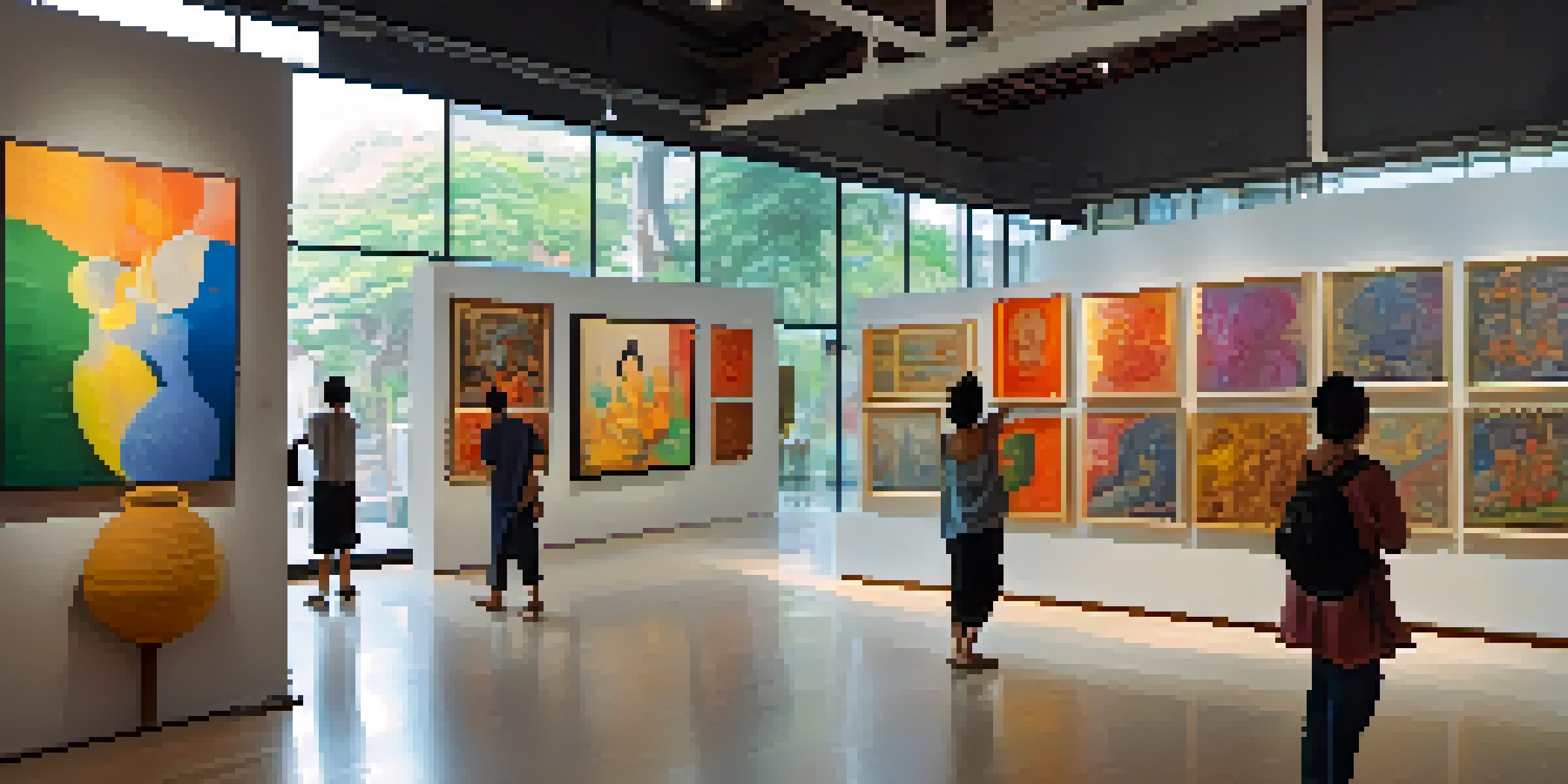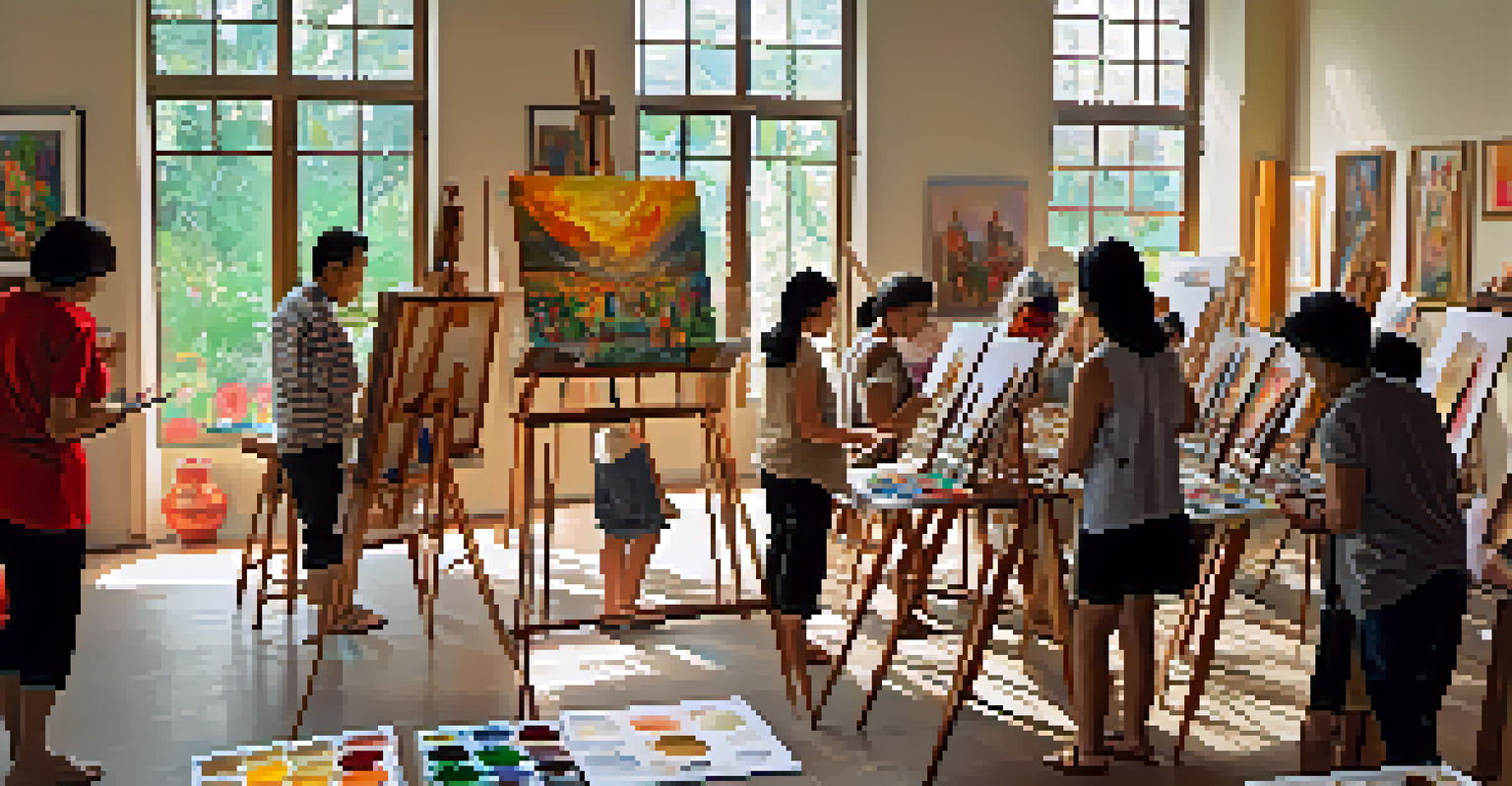The Role of Art Galleries in Thailand's Cultural Landscape

Art Galleries as Cultural Hubs in Thailand
Art galleries in Thailand serve as crucial cultural hubs, bringing together artists, collectors, and enthusiasts. They provide a space where contemporary and traditional art can coexist, allowing visitors to appreciate the rich tapestry of Thai culture. These galleries often host exhibitions that showcase local talent, fostering a sense of community and cultural pride.
Art is not freedom from discipline, but disciplined freedom.
Moreover, art galleries are instrumental in bridging the gap between local and international art scenes. By featuring both emerging and established artists, they attract a diverse audience, making Thai art more accessible to the world. This exchange of ideas not only enhances the local art community but also places Thailand on the global cultural map.
Through workshops, talks, and collaborative projects, galleries also encourage dialogue about cultural heritage and contemporary issues. This engagement cultivates a deeper understanding of Thai culture, making art a vital part of the country’s social fabric. In this way, art galleries contribute significantly to the ongoing narrative of Thailand's cultural landscape.
Promoting Emerging Artists Through Exhibitions
One of the primary roles of art galleries is to promote emerging artists who may not yet have a widespread following. By providing a platform for these creators, galleries help nurture new talent and diverse voices within the art community. This is essential for the evolution of art in Thailand, as fresh perspectives lead to innovative expressions.

Galleries often organize solo and group exhibitions that highlight the work of up-and-coming artists, giving them visibility and recognition. These exhibitions can be pivotal in an artist's career, offering them a chance to connect with curators, collectors, and the public. It’s not just about showcasing art; it’s about creating opportunities for growth and collaboration.
Art Galleries as Cultural Hubs
Art galleries in Thailand connect artists and the community, showcasing both contemporary and traditional art to celebrate Thai culture.
Furthermore, many galleries engage in mentorship programs that pair established artists with newcomers. This relationship not only builds skills but also fosters a sense of belonging within the art community. In this nurturing environment, creativity flourishes, and the future of Thai art looks promising.
Art Galleries and Cultural Preservation Efforts
In addition to promoting contemporary art, many galleries in Thailand play a vital role in cultural preservation. They often feature traditional art forms and crafts, showcasing the rich heritage of the nation. By doing so, they help keep these art forms alive and relevant in a rapidly changing world.
The role of the artist is to ask questions, not to answer them.
Exhibitions dedicated to traditional techniques, such as silk weaving or pottery, educate visitors about the historical significance and cultural context of these practices. This not only honors the artisans who have passed down these skills but also inspires a new generation to explore their heritage. The galleries become a bridge connecting the past with the present.
Moreover, many galleries collaborate with local communities to support and promote indigenous art forms. These partnerships help sustain cultural practices that might otherwise be at risk of fading away. By celebrating and preserving these traditions, art galleries contribute to a richer, more diverse cultural landscape in Thailand.
Engaging the Public: Workshops and Events
Art galleries in Thailand go beyond simply displaying artwork; they actively engage the public through workshops and events. These activities invite people of all ages to participate in the creative process, making art more accessible and enjoyable. By breaking down barriers, galleries encourage individuals to explore their artistic expression.
Workshops often cover a range of topics, from painting and sculpture to digital art and photography. This variety allows participants to discover new skills and passions, fostering a love for the arts. When people feel connected to art on a personal level, it enhances their appreciation for the broader cultural landscape.
Supporting Emerging Artists
Galleries provide vital platforms for emerging artists, promoting their work and facilitating growth through exhibitions and mentorship programs.
Events such as gallery openings, artist talks, and community festivals further enrich the experience. They provide opportunities for dialogue and exchange, allowing visitors to engage directly with artists and their work. This interaction not only demystifies art but also strengthens the bond between the gallery and the community.
Art Galleries as Platforms for Social Commentary
In recent years, many Thai art galleries have become platforms for social commentary, addressing pressing issues through the lens of art. By tackling themes such as political unrest, environmental concerns, and cultural identity, galleries encourage critical thinking and dialogue among visitors. This role is particularly vital in a society where art can provoke thought and inspire change.
Exhibitions that focus on social issues often resonate deeply with the audience, sparking conversations that extend beyond the gallery walls. Artists use their work to reflect the realities of life in Thailand, offering perspectives that may challenge the status quo. This engagement can empower individuals and communities to advocate for change.
Additionally, galleries may collaborate with non-profit organizations to support causes relevant to the local context. By aligning art with activism, they amplify important messages and contribute to a more informed society. This intersection of art and social issues underscores the transformative power of creativity in Thailand.
The Influence of Technology on Art Galleries
Technology has significantly transformed the way art galleries operate in Thailand, enhancing accessibility and engagement. With the rise of virtual exhibitions and online platforms, galleries can reach a wider audience beyond their physical locations. This shift has allowed art lovers from around the globe to experience Thai art without the need for travel.
Moreover, galleries are increasingly using social media and digital marketing to promote exhibitions and events. This approach not only attracts visitors but also creates a vibrant online community of art enthusiasts. The ability to connect with potential audiences in real-time is a game-changer for galleries aiming to stay relevant in a fast-paced digital world.
Engaging the Community Through Events
Workshops and events hosted by galleries make art more accessible, allowing the public to engage creatively and connect directly with artists.
Additionally, technology enables artists to experiment with new forms of expression, such as digital art and interactive installations. This fusion of art and technology opens up exciting possibilities, encouraging innovation within the Thai art scene. As galleries embrace these advancements, they continue to evolve, reflecting the dynamic nature of contemporary culture.
Future Directions for Art Galleries in Thailand
As Thailand's cultural landscape continues to evolve, art galleries will play an essential role in shaping its future. The increasing globalization of art presents both challenges and opportunities for local galleries. By embracing their unique identity and heritage, they can carve out a distinct space in the international art scene.
Furthermore, galleries must remain adaptable to changing audience preferences and technological advancements. This could mean diversifying programming, incorporating more interactive and immersive experiences, or exploring new mediums. Staying attuned to the needs and interests of the community will ensure that galleries remain relevant and impactful.

Ultimately, the future of art galleries in Thailand lies in their ability to foster creativity, promote cultural dialogue, and champion social change. By nurturing emerging talent and engaging the public, they will continue to enrich the cultural landscape, ensuring that art remains a vibrant and vital part of Thai society.